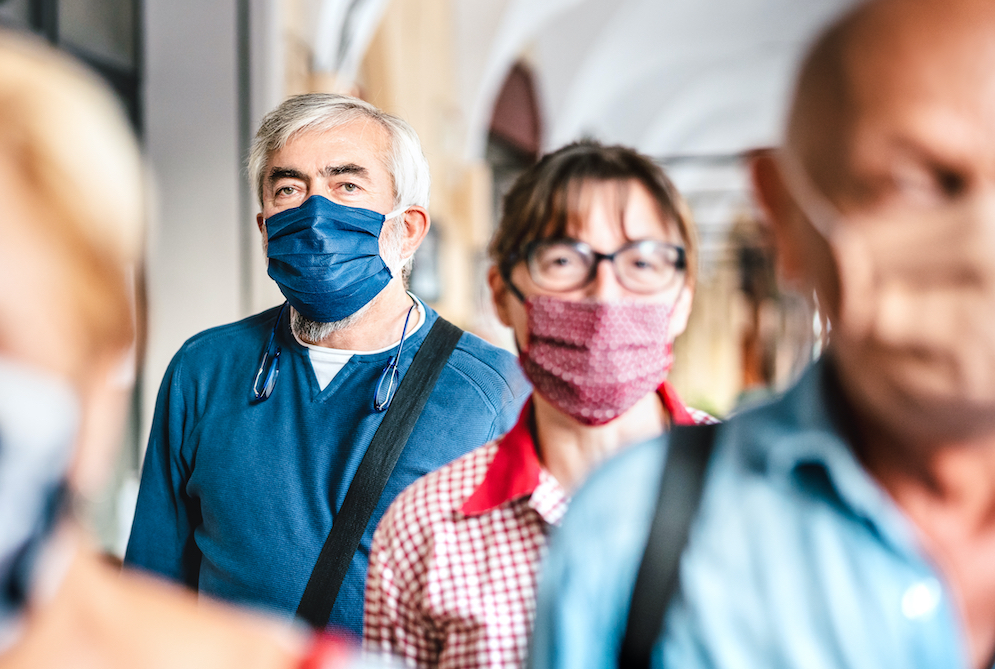
The COVID-19 pandemic has had a profound impact on the mental health and living conditions of people across the globe. Mental health professionals, policy makers and the public have expressed concerns that this could lead to an increase in suicide rates (Gunnell et al., 2020), potentially adding to the estimated 800,000 people worldwide dying by suicide every year.
In this blog, we outline the findings of a study describing international suicide rates in the early stages of the COVID-19 pandemic. This responded to the concerns about apparently contradictory findings from a range of studies (some with methodological limitations) over whether suicide rates had changed over this period.
The authors of the study aimed to gain a picture of the effect of the COVID-19 pandemic on suicide rates internationally by gathering real-time data from official sources and comparing the observed numbers of suicides with the numbers expected based on the underlying temporal trends. This is an important undertaking, and in a related blog (Appleby, 2021), an author of this study acknowledged:
It’s important to stress that the graphs and figures that are used to answer this question are not dry data. They represent real lives lost, real families devastated. No suicide rate, whether high or low, rising or falling, is acceptable.

The present study aimed to gain an international picture of the effect of the COVID-19 pandemic on suicide rates by gathering real-time data from official sources and comparing the observed numbers of suicides with the numbers expected based on the underlying temporal trends.
Methods
The authors sought real-time suicide data from individual countries, capturing the recording of suspected suicides as they occurred via local sources such as police or death certificates, and providing the potential for early detection of risk patterns (Appleby et al., 2021). Real-time suicide surveillance systems pre-date the COVID-19 pandemic and despite the potential for bias in how they classify a suspected suicide, they offer responsiveness advantages over the traditional system of waiting for official suicide statistics, which can take up to a year following the coronial process.
The authors searched for real-time suicide data using countries’ official websites, as well as broader internet searches, academic literature and their contacts at international suicide prevention organisations. To be included, data had to originate from official government sources, cover countries or areas within countries, and be available from at least 1st Jan 2019 to 31st July 2020 at a monthly level.
To model the trends in monthly suicides before COVID-19 in each country or area, the authors used interrupted time-series analysis, accounting for time trends and seasonality wherever possible.
Results
The authors sourced data from 21 countries (16 high-income countries and 5 upper-middle income countries), covering the period until the end of July 2020, and in some cases, until the end of October 2020.
For all countries or areas included in the study, there was no evidence of an increase in suicides from the start of the pandemic until the end of July 2020 compared to figures expected based on pre-pandemic temporal trends. In 12 countries or areas (Ecuador; Japan; New Zealand; South Korea; Leipzig, Germany, and several areas in Australia, Canada, and the USA) there was evidence of a significant decrease in suicides.
One sensitivity analysis highlighted the importance of taking a longer-term view. When the analysis included additional data (available for some areas) until the end of October 2020, the results remained unchanged for most countries. However, three areas where no difference had been observed in the main analysis showed an overall reduction in suicides over this longer period (Thames Valley, UK; Mexico City, Mexico; Victoria, Australia), whilst three showed an increase (Japan; Puerto Rico; Vienna, Austria). It will be important for the living systematic review, led by the International COVID-19 Suicide Prevention Research Collaboration (ICSPRC), to continue with its valuable outputs to monitor trends.

For all countries or areas included in the study, there was no evidence of an increase in suicides from the start of the pandemic until the end of July 2020 compared to figures expected based on pre-pandemic temporal trends.
Conclusions
The authors concluded that there is no evidence to support an increase in suicide rates during the pandemic’s early months in the 21 countries for which they accessed data. This consistent finding across many countries increases confidence in these conclusions and suggests that COVID-19 risk mitigation measures may not have led to population-level increases in suicide rates during this period. This could be attributed to various protective factors mitigating the potential for increases in suicides:
- Social adaptations (e.g., communities supporting at-risk individuals, individuals connecting in new ways; households spending more time with each other) may have improved social support.
- Individuals with depressive or anxiety symptoms, or suicidal thoughts, may have been able to access flexible, high-quality mental healthcare within the statutory and voluntary sectors. This seems unlikely within the UK (Samaritans, 2021).
- Occupational stressors may have been reduced for some people working from home.
- Being united in common adversity might have contributed to a sense of societal integration or solidarity.
- The rapid, financial support offered to individuals and businesses in many countries (such as furlough schemes) may have buffered the economic consequences of the pandemic.
This picture is neither complete nor final but serves as the best available evidence on the pandemic’s early effects on suicide rates.

There is no evidence to support an increase in suicide rates during the pandemic’s early months in the 21 countries for which the authors accessed data. This picture is neither complete nor final, but serves as the best available evidence on the pandemic’s early effects on suicide rates.
Strengths and limitations
This study is the first to combine data from multiple countries to examine the early effects of COVID-19 on suicide, taking into account pre-pandemic trends. However, it is important to understand that it describes only the early stage of the pandemic, and findings cannot be extrapolated to future phases. Given what we know about the anticipated longer-term effects (Gunnell et al., 2020), the links between economic factors and suicide (Lewis & Sloggett, 1998), and the importance of social protections in cushioning economic shocks (Karanikolos et al., 2013), this finding does not rule out a lag in suicides whilst risk factors accumulate.
Short timeframe
The study necessarily covers only the early months of the pandemic. However, the risk of suicide associated with the pandemic is likely to be dynamic and risk factors may change over different stages of the pandemic with varying levels of support and accumulating economic challenges. In Japan, the initial decrease (until July 2020) followed by an increase in suicide rates evidences their dynamic nature (Ueda et al., 2021). Mental health consequences are likely to last longer and peak later than the pandemic itself (Gunnell et al., 2020). The short timeframe covered also presents issues of power. Some included countries had low numbers of monthly suicides, and findings from those areas should be interpreted with caution.
Focus on higher-income countries
The study did not represent findings from low-income or lower-middle-income countries due to a lack of reliable data: a long-standing issue. These countries account for 46% of the world’s suicides (World Health Organization, 2014). Many have been hit particularly hard by the pandemic and do not have strong economic safety nets. It is possible that the risk of suicide during the pandemic has differed in those settings, and may continue to evolve differently.
Unknown trends among demographic groups
The study provides a picture only at the level of the whole population for many included countries, and the analysis was unable to stratify the data by age, gender, ethnicity, socioeconomic status, or sexual orientation. These are key sociodemographic risk factors for suicide, yet by averaging across the whole population, worrying trends among certain demographic groups may have been obscured.
This is important because the pandemic may have had differential effects on mental health and suicide risk in different demographic groups, exacerbating previous inequalities across the social gradient and for ethnic and other minorities. The pandemic created a mix of protective and risk factors relating to mental health (Gunnell et al., 2020): it is likely that some groups enjoyed many of the protective factors and few of the negative, with the converse applying to those already at high risk for poor health outcomes, including suicide. Qualitative work suggests that people with pre-existing mental health problems have particularly struggled during the pandemic, perceived especially among those in ethnic minority groups (Gillard et al., 2021).
These concerns are supported by data on suicides in Maryland, USA from 1st Jan 2017 to 7th July 2020 (not included in the present study due to inclusion criteria on dates). During a two month period early in the pandemic, suicides in Maryland increased significantly in black groups and decreased significantly in white groups (Bray et al., 2021). Over the whole six months, period suicide rates fell significantly, and markedly in white groups, but were unchanged in black groups (Bray et al., 2021). This finding underscores the importance of looking at more fine-grained data in order not to miss worrying trends sub-nationally in specific populations defined by ethnicity, age, gender, or region (Pitman et al., 2012).

This study is the first to combine data from multiple countries on the early effects of COVID-19 on suicide, taking into account pre-pandemic trends. However, it describes only the early stage of the pandemic and at the level of the whole population, so findings cannot be extrapolated to future phases or demographic groups.
Implications for practice
- Continue to monitor real-time data and be alert to any increases in suicide, particularly as the pandemic’s full economic consequences emerge and financial support is withdrawn or reduced in most countries.
- Redouble our efforts to understand the pandemic’s effects on suicides in low-income and lower-middle-income countries, by supporting them to collect mortality data (both on COVID-related deaths and suicides).
- Understand what has buffered the negative impacts of COVID-19 mitigation measures on suicide rates during the pandemic’s early months, and what drives any increases should they occur. A comparison of suicide trends in countries that implemented additional mental health supports and/or financial safety nets may help understand the contribution of service non-responsiveness and/or fiscal austerity.
- Countries must ensure that mental health services remain responsive, and provide appropriate financial protections, rather than becoming complaisant regarding mental health impacts.
- Recognise that suicide is not the only indicator of the negative mental health effects of the pandemic; levels of community distress are high, and we need to ensure that people are supported.
- The research community has struggled over the course of the pandemic to establish clear communication lines with the media and the policy community, and this needs to be addressed so that researchers can communicate findings on mental health impacts to governments and communities in safe, non-sensationalist ways as a means of influencing policy appropriately.
- Rises in suicide rates are not inevitable in times of national crisis, and the media should be aware of this study’s findings in tempering a tendency to sensationalism over adverse impacts (Hawton et al., 2021).

We need to continue monitoring real-time data and be alert to any increases in suicide, ensure that mental health services remain responsive and understand the protective factors on suicide rates during the pandemics’ early months.
Support
If you have been affected by the issues discussed in this article and feel you need support, please consult this website provided by the Oxford Health BRC or the Samaritans.
Statement of interests
Alexandra Pitman has worked with some of the authors of the primary paper on other projects and works clinically for the Camden and Islington NHS Foundation Trust, but had no involvement in this study.
Links
Primary paper
Pirkis, J., John, A., Shin, S., DelPozo-Banos, M., Arya, V., Analuisa-Aguilar, P., Appleby, L., Arensman, E., Bantjes, J., Baran, A., Bertolote, J. M., Borges, G., Brečić, P., Caine, E., Castelpietra, G., Chang, S. Sen, Colchester, D., Crompton, D., Curkovic, M., … Spittal, M. J. (2021). Suicide trends in the early months of the COVID-19 pandemic: an interrupted time-series analysis of preliminary data from 21 countries. The Lancet Psychiatry, 0366(21), 1–10.
Other references
Appleby, L. (2021). Louis Appleby: What has been the effect of covid-19 on suicide rates? British Medical Journal.
Appleby, L., Richards, N., Ibrahim, S., Turnbull, P., Rodway, C., & Kapur, N. (2021). Suicide in England in the COVID-19 pandemic: Early observational data from real time surveillance. The Lancet Regional Health – Europe, 4, 100110.
Bray, M. J. C., Daneshvari, N. O., Radhakrishnan, I., Cubbage, J., Eagle, M., Southall, P., & Nestadt, P. S. (2021). Racial Differences in Statewide Suicide Mortality Trends in Maryland During the Coronavirus Disease 2019 (COVID-19) Pandemic. JAMA Psychiatry, 78(4), 444–447.
Gillard, S., Dare, C., Hardy, J., Nyikavaranda, P., Rowan Olive, R., Shah, P., Birken, M., Foye, U., Ocloo, J., Pearce, E., Stefanidou, T., Pitman, A., Simpson, A., Johnson, S., & Lloyd-Evans, B. (2021). Experiences of living with mental health problems during the COVID-19 pandemic in the UK: a coproduced, participatory qualitative interview study. Social Psychiatry and Psychiatric Epidemiology, 0123456789.
Gunnell, D., Appleby, L., Arensman, E., Hawton, K., John, A., Kapur, N., Khan, M., O’Connor, R. C., Pirkis, J., Caine, E. D., Chan, L. F., Chang, S. Sen, Chen, Y. Y., Christensen, H., Dandona, R., Eddleston, M., Erlangsen, A., Harkavy-Friedman, J., Kirtley, O. J., … Yip, P. S. (2020). Suicide risk and prevention during the COVID-19 pandemic. The Lancet Psychiatry, 7(6), 468–471.
Hawton, K., Marzano, L., Fraser, L., Hawley, M., Harris-Skillman, E., & Lainez, Y. X. (2021). Reporting on suicidal behaviour and COVID-19—need for caution. The Lancet Psychiatry, 8(1), 15–17.
Karanikolos, M., Mladovsky, P., Cylus, J., Thomson, S., Basu, S., Stuckler, D., MacKenbach, J. P., & McKee, M. (2013). Financial crisis, austerity, and health in Europe. The Lancet, 381(9874), 1323–1331.
Lewis, G., & Sloggett, A. (1998). Suicide, deprivation, and unemployment: Record linkage study. British Medical Journal, 317(7168), 1283–1286.
Pitman, A., Krysinska, K., Osborn, D., & King, M. (2012). Suicide in young men. The Lancet, 379(9834), 2383–2392.
Samaritans. (2021). Mental Health. Life during the Pandemic.
Ueda, M., Nordström, R., & Matsubayashi, T. (2021). Suicide and mental health during the COVID-19 pandemic in Japan. Journal of Public Health, 3, 1–21.
World Health Organization. (2014). Preventing suicide Preventing suicide. WHO Library Cataloguing-in-Publication Data, 89.
